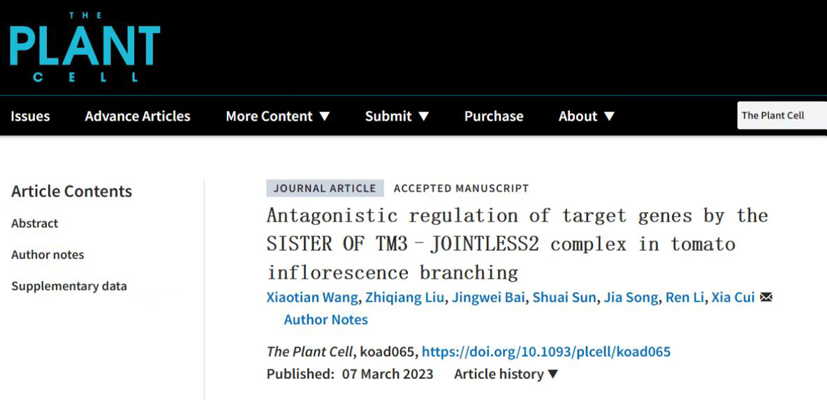The number of branches in the inflorescence affects yield in food crops and the aesthetics of ornamental plants. The appropriate number of inflorescence branches has become an important indicator of excellent tomato varieties. Two MADS-box transcription factors, SISTER OF TM3 (STM3) and JOINTLESS2 (J2), are tomato homologs of Arabidopsis SUPPRESSOR OF OVEREXPRESSION OF CONSTANS 1 and SEPALLATA 4, respectively, and have opposing regulatory functions in controlling inflorescence branching. However, the regulatory mechanism of STM3 and J2 antagonistically regulate inflorescence branching is still unclear.

Recently, The Plant Cell published online a research paper titled "Antagonistic regulation of target genes by the SISTER OF TM3-JOINTLESS2 complex in tomato inflorescence branching" by the Molecular Improvement of Quality Group of the Institute of Vegetable and Flower Research, Chinese Academy of Agricultural Sciences (IVF, CAAS). This study used chromatin immunoprecipitation followed by high-throughput sequencing (ChIP-seq) and electrophoretic mobility shift assays to identify and confirm a set of common putative target genes that are directly bound by STM3 and J2 via the CArG box motif in their promoter regions. One of these direct targets, FRUITFULL1 (FUL1), is antagonistically regulated by STM3 and J2 during inflorescence development. STM3 forms a complex with J2 and mediates its translocation from the cytosol to the nucleus, thus restricting J2 repressor activity. J2 also limits STM3 function by repressing STM3 expression and inhibits its binding activity. This study suggest an antagonistic regulatory mode in which STM3 and J2 exert flexible control over inflorescence meristem determinacy and branch number, and provides a new idea for in-depth understanding of plant inflorescence development.

Dr. Xiaotian Wang, Ph.D. candidate Zhiqiang Liu, and postgraduate student Jingwei Bai from IVF, CAAS are the co-first authors, and researcher Cui Xia is the corresponding author of the paper. The research were supported by the National Natural Science Foundation of China (31930099), the National Key Research and Development Program (2022YFF1003002) and the Science and Technology Innovation Project of the Chinese Academy of Agricultural Sciences.
Original link: https://academic.oup.com/plcell/advance-article/doi/10.1093/plcell/koad065/7071455